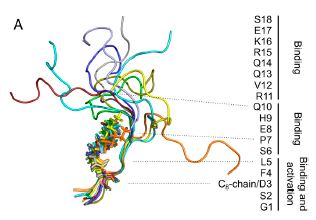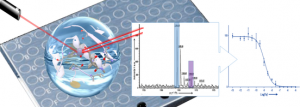
Sonia Cantel
Associate Professor-HDR, Faculty of Sciences, University of Montpellier
Sonia Cantel obtained her PhD in 2004 in Chemistry of Biomolecules from the University of Montpellier, under the supervision of Dr. J-A Fehrentz, in the field of pseudo-peptide and solid phase organic synthesis. Then, she joined the group of Pr. M. Chorev for the following two years as a Post-doctoral Fellow in the Laboratory for Translational Research (Harvard Medical School, Boston, USA). She actively participated to biomedicinal projects where chemistry plays a critical role but also required the input of other scientific disciplines. In this interdisciplinary research environment, she developped extensive skills in analytical techniques applied to protein engineering. Her accomplishments included development of new methodologies for synthesis of glycated antigenic peptides and in situ templated assembly of fragments to generate potent inhibitors of protein-protein interaction.
She joined in 2007 the group of Professor J. Martinez as an Assistant-Professor at the University of Montpellier in Mass Spectrometry, taking advantage of her multidisciplinary experience to develop new projects at the interface of Chemistry, Biology and Analytical Sciences.
She focuses her research on the development of chemical probes for specific and sensitive detection of peptides and proteins, and pharmacological studies (GPCR/ligand interaction) by MALDI Mass Spectrometry.
Contact:
sonia.cantel@umontpellier.fr
Major publications :
- “Quantitative MALDI-MS Binding Assays: An Alternative to Radiolabeling”, Rossato, G. Miralles, C. M’Kadmi, D. Gagne, M. Amblard, B. Mouillac, J. Martinez, G. Subra, C. Enjalbal and S. Cantel, ChemMedChem, 11 (23), 2582-2587 (2016) IF= 2.98
- “Angiotensin-Converting Enzyme is the target of the nonapeptide Acein that induces dopamine release” Neasta, C. Valmalle, A.C. Coyne, E. Carnazzi, G. Subra, J.C. Galleyrand, D. Gagne, C. M’Kadmi, N. Bernad, G. Bergé, S. Cantel, J. Marie, J.L. Banères, M.L. Kemel, V. Daugé, K. Puget, J. Martinez, British Journal of Pharmacology, 173, 1314-1328 (2015) IF= 4.84
- “An innovative Strategy for sulfopeptides analysis using MALDI-TOF MS reflectron positive ion mode” CANTEL, L. BRUNEL, K. OHARA, C. ENJALBAL, J. MARTINEZ, J.J. VASSEUR, M. SMIETANA*, Proteomics, 12, , 2247-2257 (2012). IF = 4,82
- “A new generation of cross-linkers for selective detection by MALDI MS”, D. PARAMELLE, CANTEL, C. ENJALBAL, M. AMBLARD, E. FOREST, M. HEYMANN, C. GEOURJON, J. MARTINEZ, G. SUBRA, Proteomics, 9, 5384-5388 (2009). IF = 4,82
- “Synthesis and Conformational Analysis of a Cyclic Peptide Obtained via i to-i+4 Intramolecular Side Chain-to-Side Chain Azide-Alkyne 1,3-Dipolar Cycloaddition”, CANTEL, A. LE CHEVALIER-ISAAD, M. SCRIMA, J.J. LEVI, R.D. DIMARCHI, P. ROVERO, J.A. HALPERIN, A.M. D’URSI, A.M. PAPINI, M. CHOREV, J. Org. Chem. (Featured Article), 73, 5663-5674 (2008). IF = 3,96
- “Small Molecule Inhibition of the Interaction Between the Translation Initiation Factors eIF4E and eIF4G”, N.J. MOERKE, H. AKTAS, H. CHEN, CANTEL, M.Y. REIBARKH, J.D. GROSS, A. DEGTEREV, J. YUAN, M. CHOREV, J.A. HALPERIN, G. WAGNER, Cell, 128, 257-267 (2007). IF = 29,89
- “Solution and solid-supported synthesis of 3,4,5-trisubstituted 1,2,4-triazole-based peptidomimetics” D. BOEGLIN, CANTEL, A. HEITZ, J. MARTINEZ, J.A. FEHRENTZ, Org. Lett., 5, 23, 4465-4468 (2003). IF = 5,25
Recent publication with the group
- “N-terminal LEAP2 region exhibits inverse agonist activity toward the ghrelin receptor“, M’Kadmi, A. Cabral, F. Barrile, J. Giribaldi, S. Cantel, M. Damian, S. Mary, S. Denoyelle, S. Dutertre, S. Péraldi-Roux, J. Neasta, C. Oiry, J.L. Banères, J. Marie, M. Perello and J.A. Fehrentz , J. Med. Chem. in press (2018) IF= 6.25
- Receptor-ligand interaction measured by Inductively Coupled Plasma Mass Spectrometry and selenium labeling“, Cheignon, E. Cordeau, Nolwenn Prache, S. Cantel, J. Martinez, G. Subra, C. Arnaudguilhem, B. Bouyssiere, C. Enjalbal, (2018) J.Med.Chem., 61, 10173-10184 (2018) IF= 6.25






